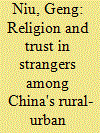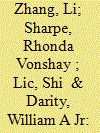| Srl | Item |
| 1 |
ID:
161864


|
|
|
|
|
| Summary/Abstract |
During China's rapid urbanization, the social marginalization of its rural-urban migrants has attracted increasing scholarly and social attention. At the same time, China is experiencing a rising tide of religion, the impact of which on social integration remains unexplored. Based on a large-scale survey for rural-urban migrants, we find that being a religious believer is associated with a higher level of trust towards strangers. In addition, participating in religious-related activities has a positive impact on trust for both believers and non-believers. We test the robustness of our results using instrumental variable analysis. We conjecture that prosocial values in religious teaching and social interaction opportunities contribute to rural-urban migrants' generalized trust. Our results indicate that informal institution such as religion can be important in forming social capital for marginalized social groups.
|
|
|
|
|
|
|
|
|
|
|
|
|
|
|
|
| 2 |
ID:
149771


|
|
|
|
|
| Summary/Abstract |
Since the end of the 1980s, the number of migrants working in the urban labor market has increased dramatically. However, migrant workers are treated differently from urban workers. In this paper we examine the labor market discrimination against rural migrants from the point of view of wage differentials using CHIP-2007 data. We apply Jann pooled method to deal with index number problem and use Heckman two step model to correct selection problem when decomposing the wage gap. The decomposition results show that a significant difference in wage gains persists between the two groups as late as 2007. In 2007 migrants only earned 49% of urban workers' income and 17% of the wage gap cannot be explained by observed factors. In detail, differences in educational attainment, work experience and distribution across industry, occupation, and ownership of enterprises account for most of the explained wage gap.
|
|
|
|
|
|
|
|
|
|
|
|
|
|
|
|